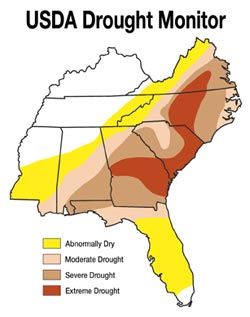Weather Plays Havoc With Alabama Crops

While Fayette County farmer Lance Whitehead replanted cotton in his fields that had been flooded, 200 miles to the south, Lowndes County farmer Ronnie Holladay had to wait for rain so he could plant the last of his cotton.Whether it’s too much rain or not enough, it seems just about every farmer is battling the elements this year. “We have been stressed with a lot of weather conditions that we normally don’t face,” Whitehead said. “The conditions are causing quite a few problems, and we are dealing with them now.”Farmers are especially concerned about low soil moisture levels. According to the Alabama Agricultural Statistics Service, Mobile and Dothan were 10 inches below normal for rainfall during the first five months of 2002. Meanwhile, cool weather and heavy rain delayed planting in north Alabama. Farmers say it is too early to know how much of an effect the weather will have on their crops. “We have the potential to lose yields,” Whitehead said. “However, a lot of that may depend on when we get our first freeze. It definitely has decreased our chances of making our best yields.”Holladay said it’s still not too late to have a good crop of cotton, corn and soybeans, but added that it’s critical the rain continue throughout the next few weeks.”We got an inch to an inch and seven-tenths (in May), and it was certainly a welcome relief,” Holladay said. “We were waiting for a rain to plant the last of our cotton, and I hope we get a stand. We’re several weeks behind where we need to be because of the dry weather.”The drought also is affecting the state’s beef producers. Farmers are feeding their cows because pastures are shorter than normal for this time of the year.
Escambia County farmer Rodney Rhodes has been feeding his cattle since winter. He said surplus hay from last year was a blessing in disguise.”Everyone wanted to sell all their extra hay last year, but luckily we still have a lot of hay baled up,” Rhodes said. “I will be feeding my cows until the end of June with it.” Like Rhodes, Dale County Farmer Chris Carroll is concerned about feeding his 275 brood cows. Right now, he is just feeding one herd, but if it doesn’t rain soon, he will have to start feeding more.”Early spring is when the grass is supposed to be growing, and this is very disappointing,” said Carroll. “If we don’t get rain, my feed bill will go up, and my cows are going to be lighter.”
Not only is the dry weather affecting cattlemen, but row crop producers also are feeling the costly effects.Elmore County farmer Richard Edgar said the lack of rain has caused him to replant about 40 acres of cotton, and insect damage due to the dry weather might cause him to replant more. Edgar said the replanted acres could pose a problem when he begins spraying and harvesting his cotton.”We will have a great variation in the maturity of the crop,” Edgar said. “This will come into play when we look at defoliation in particular, and it will make weed control difficult, because the cotton will be in so many stages or heights.”Corn, too, is suffering from dry weather and heat. Conecuh County farmer John Cook said, as of the first of June, his tallest corn was at 6 feet and it should be 8-9 feet tall. “The dry weather has severely affected our tonnage and our grain yield, but we are not sure how much yet,” Cook said. “We have a dairy farm, and this has forced us to cut more acres of silage to get the required tonnage to make it.”Chilton County Area Horticulturist Bobby Boozer said the dry weather means shoppers could find smaller peaches at their favorite roadside stand this year, particularly early in the season. He is optimistic, however, that producers will still be able to make a good crop. “For a lot of growers, fruit size was not a problem, because they were able to thin their trees to relieve stress,” Boozer said. “With good fruit thinning and irrigation, the fruit size has been normal, so there are both types out there.”While farmers in south Alabama have been battling the drought, producers in north Alabama have been dealing with too much rain. As of mid-May, Whitehead still had 500 acres of cotton left to plant, because the fields had been so wet. “So much rain has fallen at one time that water has stood in low-lying areas and certain places in the field,” Whitehead said. “It’s not been just in small places either. So much water has fallen so fast that it has covered two- and three -acre areas of the field.”For Whitehead, time is the biggest enemy because there is not enough equipment or labor to cover the land that needs to be planted.Adding to Whitehead’s problem was a cold spell that swept through Alabama in mid-May. “All the cotton plants are stressed,” Whitehead said. “It’s too early to tell what effect the excess rain and cool weather will have on the crop. But one thing is for sure, it hasn’t helped.”
